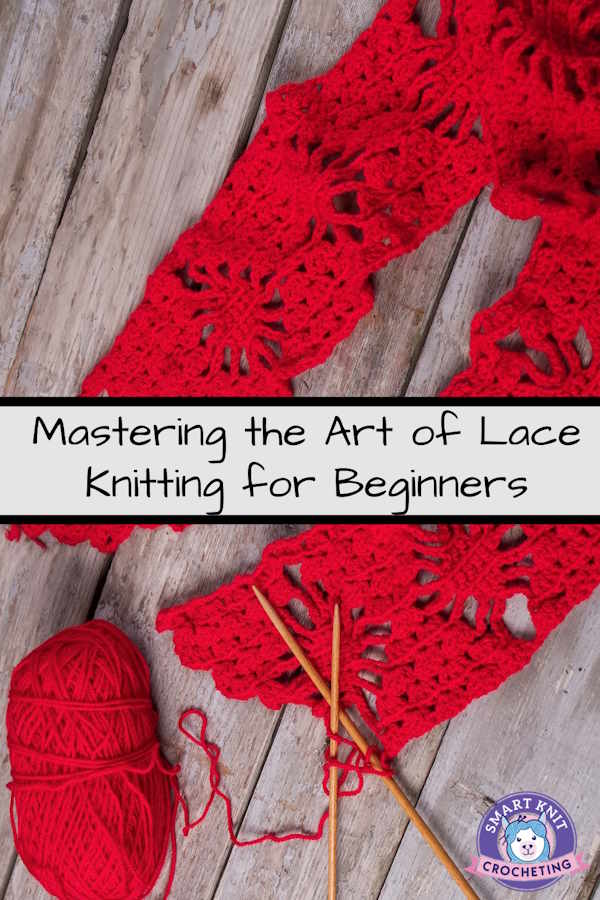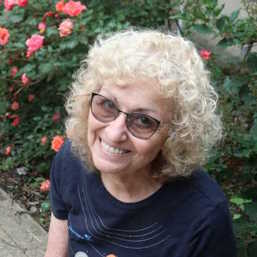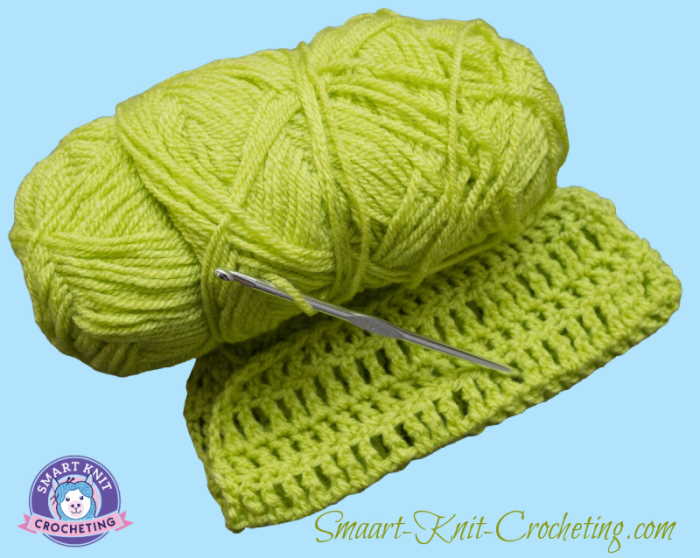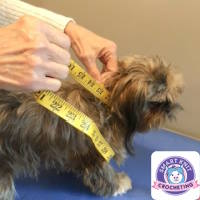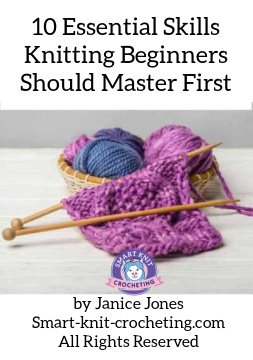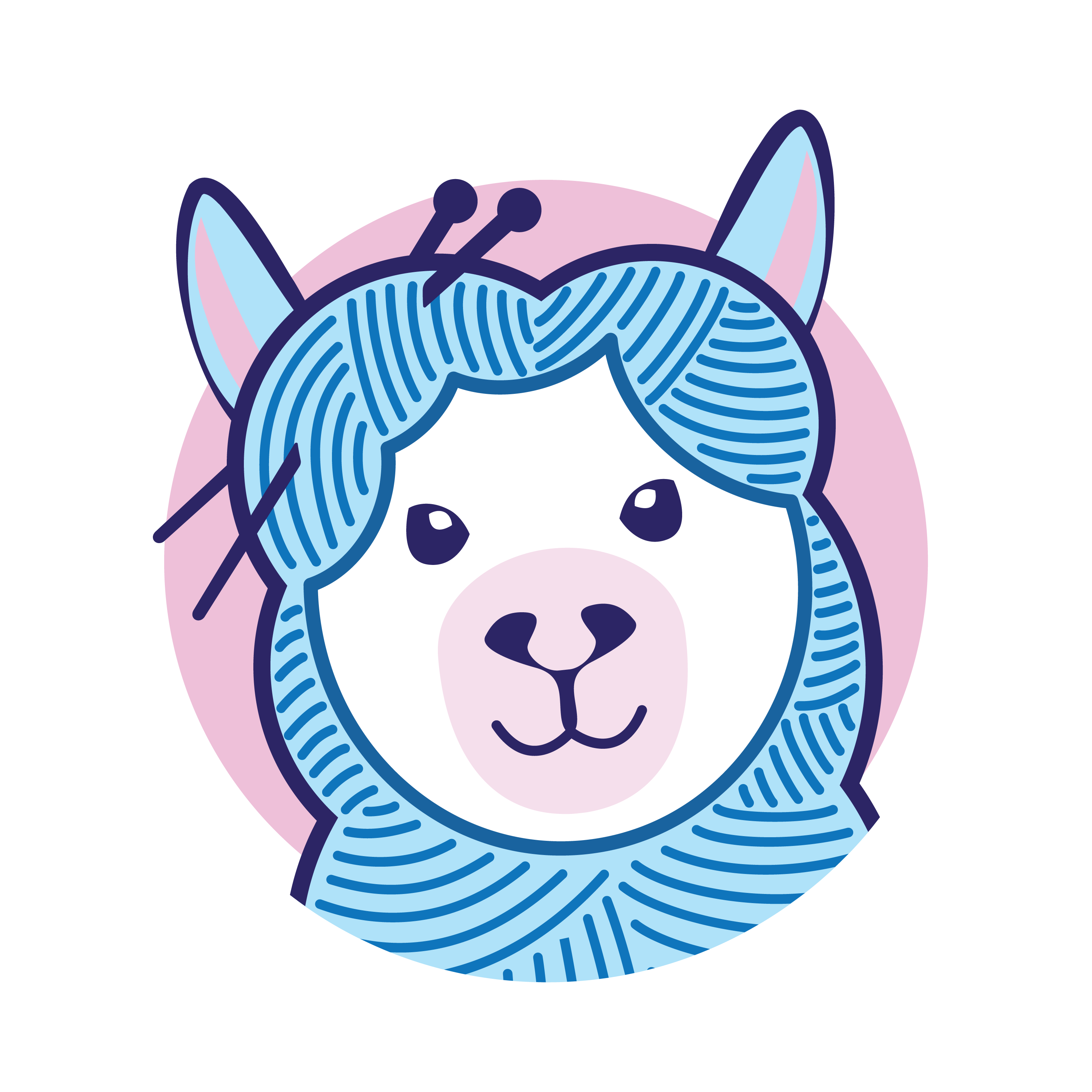- Home
- Lace and Eyelet Stitches
Lace Knitting Stitches: Easy Lace and Eyelet Patterns
by Janice Jones
Lace knitting is an intricate art form that creates delicate patterns using yarn and knitting needles.
It is a technique that requires a certain level of skill and attention to detail. In this article, I will share some tips and tricks that will help you master the art of lace knitting stitches.
If you are interested in the lace knitting stitches I have provided, feel free to jump down the page.
Why Consider Lace Knitting as Beginner-Friendly?
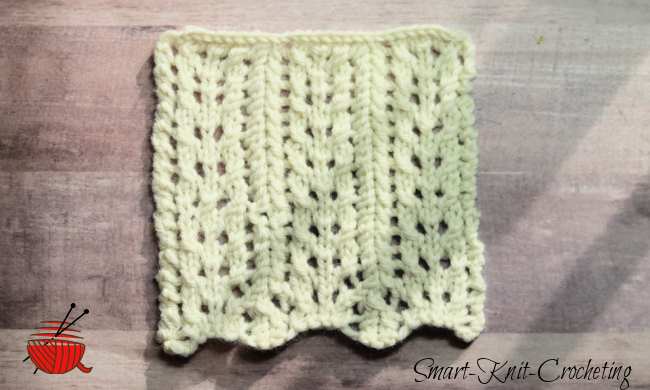
Last week my daughter got dressed for the theater, a lovely dress, stilettos, and a lightweight hoodie. There was just something that needed to be fixed with the look. I decided I needed to make her a lovely lace shawl for such occasions.
Lace is not a strength for me, but following simple lace designs is well within the realm of beginning knitters. Yes, lace can be very complex, and those patterns should be reserved for advanced knitters.
Is There a Difference Between Lace and Eyelets
Eyelets are used in a variety of clothing fashions, but in knitting, eyelets are small holes created by yarn-overs that add a decorative element to the fabric.
Lace is a broader term that refers to any pattern that has holes in it. Eyelets are often used in lace patterns to create movement and texture.
Benefits of Lace Knitting

Lace knitting has numerous benefits, both physical and mental. It is a great way to reduce stress, improve cognitive function, and boost creativity. The repetitive motion of knitting can be soothing and meditative, allowing you to relax and unwind after a long day.
Additionally, lace knitting can be a great way to challenge yourself and improve your knitting skills. It requires a certain level of precision and attention to detail, which can help you improve your focus and concentration.
There may be a few knitting techniques that you will need to know, including how to read lace charts, simple increases and decreases, and how to make simple eyelets. That might seem like a lot, but it is doable.
Essential Tools for Lace Knitting
You will need some essential tools to start lace knitting, including knitting needles and yarn.
Knitting Needles

When it comes to knitting needles, choosing a pair that is the right size for your project is essential. For lace knitting, there are a few choices for needles. You will want to choose the size needle the pattern calls for. However, experimenting with several different needles might be a good idea.
Most lace work is created on either straight or circular needles. It makes good sense to pick a needle that is right for you, but here are a few thoughts to keep in mind.
- For your first attempt with lace, consider bamboo needles because they are a bit stickier, so you would be less likely to lose stitches accidentally.
- Other knitters prefer steel, brass, or aluminum needles with sharp, long tips. Many companies will call some of their needles lace needles.
For example Lace Knitting Needles include
- Addi Lace knitting needles
- ChaioGoo
- HiyaHiya Sharp
Yarn for Lace Knitting Stitches
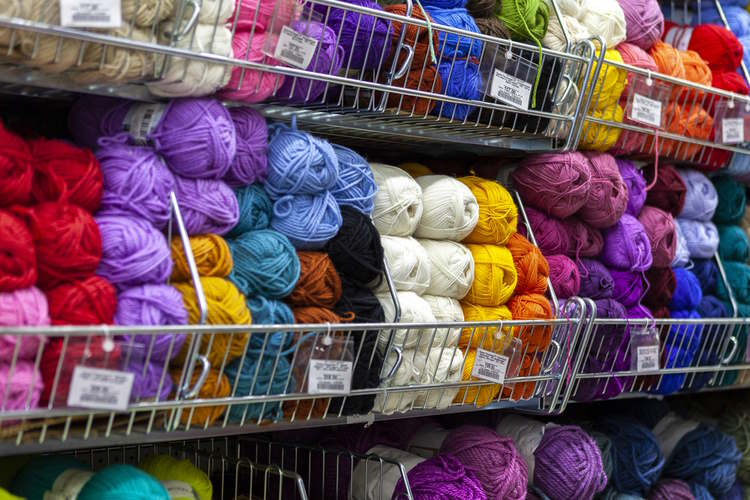
In terms of yarn, it's essential to choose a high-quality, fine yarn that will create a delicate and intricate lace pattern. Look for yarns made from natural fibers, such as wool or silk, as these will give your knitting a luxurious feel.
You can create lace with any yarn, and for the beginner accustomed to working with worsted-weight yarn (Craft Yarn Council number 4), this might be a good choice for practice. However, following a lace knitting stitch pattern, you will want to choose either the recommended yarn or a suitable substitution.
You will find yarns labeled as lace yarn, fingering, sport, or DK weights are often used in lace patterns.
Additional Helpful Supplies to Have
Beyond needles and yarn, you will want to have a couple of other supplies on hand:
- Stitch markers
- Scissors
- Tapestry Needles
- Row Counters
- Scrap yarn to create a lifeline (Your choice)
Understanding Lace Knitting Patterns
It's essential to understand the different types of patterns that are used in lace knitting. Lace patterns often involve a combination of yarn overs, knit and purl stitches, which create the intricate lace design.
Increases and decreases are used to keep the stitch count the same from row to row and still create the little delicate holes that make up the lace fabrics we are creating. For a review of increasing stitches in knitting or making decrease stitches, these two resources might help.
When reading a lace knitting pattern, paying close attention to the stitch count and pattern repeats is essential. Ensure you understand how the design works before you begin, and take your time to ensure that you follow the pattern correctly.
Row repeats are important when knitting lace. More complex patterns will require more row repeats. Using a row counter comes in handy to help keep your place.
Lace Knitting Charts
 Lace Knit Chart for the Feathers and Fan Lace Stitch Pattern
Lace Knit Chart for the Feathers and Fan Lace Stitch PatternKnitting charts are another way of writing instructions in pictorial form using symbols. Some patterns provide just the written instructions, others offer just the chart, and others provide both.
As you gain experience and confidence, you will decide which instruction delivery method works best.
The chart can give you a good sense of how your lace is created and how it will look.
Common Stitches and Abbreviations Used in a Simple Lace Pattern
Lace knit stitches are just a series of knits and purls, plus increase stitches and decrease stitches.
- Yarn Over (YO) The yarn over creates the small hole lace is famous for. The yarn over is considered to be a knitting increase stitch. Yarnovers
- Knit Two Together (k2tog) is a knitting decrease stitch. You will often find YO and K2tog paired where the pattern calls for a YO followed by a K2tog to create the holes but not change the stitch count of the row.
- Knit Three Together (K3tog): Similar to the Knit two together but you knit three stitches at the same time, decreasing two stitches
- Purl Two Together (P2tog): This is done like the knit two together, but instead you purl two together, creating a decrease on the wrong side of the fabric.
- Slip Slip Knit (SSK Decrease): A left-leaning decrease stitch that is created by first slipping one stitch from the left to the right needle as if to knit and then repeating with the second stitch on the left needle. Slip the left needle through the two stitches you just slipped with the left needle closest to you. Wrap the yarn around the right needle and knit through the back loops of the two stitches and then slide them off the left needle.
- Slip 1 with yarn in front (sl1wyif) While holding the yarn in the front, Slip one stitch from the left to the right needle without knitting it.
- Slip 1 with yarn in back (sl1wyib) While holding the yarn in the back, Slip one stitch from the left to the right needle without knitting it.
- Pass Slip Stitch Over (PSSO): Usually used with other techniques such as “slip 1, knit2tog, psso.” to create a decrease. Slip one stitch as if to knit. Knit two together, the pass the slipped stitch over top of the stitches you knit together.
Tips for Mastering Lace Knitting Stitches
To become a master of lace knitting stitches, it's important to practice regularly and pay close attention to your technique. Here are a few tips to help you improve your lace knitting skills:
- Use stitch markers to keep track of your pattern repeats. Place a stitch marker every 10 to 20 stitches.
- Select a method to keep track of where you are in the pattern.
- Get into the habit of counting stitches at the end of the row.
- Practice knitting with a lifeline to help you recover if you make a mistake.
- Keep your tension even to create a consistent and beautiful lace pattern. Yarnovers, for example, can create large holes if given too much slack. (More about tension)
- Take breaks often to avoid eye strain and fatigue.
Finishing and Blocking Lace Knit Projects
Once you have completed your lace knitting project, it's important to finish and block it properly. Blocking helps even out your stitches and create a more polished and professional-looking finished product.
To block your lace knit project, soak it in lukewarm water and lay it flat to dry. You can also pin it in place to help it maintain its shape as it dries. Learn more about blocking.

Beginner Friendly Lace Knitting Stitches
What makes lace stitches easy for the beginner? Firstly, you want to find a pattern with a minimum row pattern, such as a 4-row repeat.
Next, you want to find a pattern with a simple stitch repeat. This first stitch is one of the easiest I've ever seen.
1. Simple Garter Lace Stitch
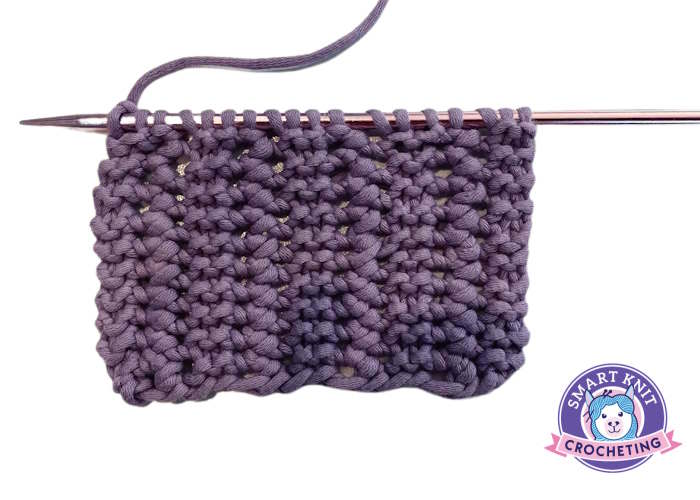
If you're new to lace stitches, you should try one first. It has one row of stitches repeated until you reach your desired length.
This pattern creates a lovely, reversible lace pattern, meaning that the right and wrong sides are identical.
Directions: Simple Garter Stitch Lace Pattern
CO a multiple of 4 + 2 stitches. For this swatch, I cast on 18 stitches.
Row 1 and all further rows:
K2, *yfrn, P2tog, K2* repeat to end of row.
That's it!
A word about yfrn:This stands for yarn forward round needle. You will see this in lace patterns where you are transitioning from a knit stitch to a purl stitch.
It is a type of yarn over, but you will need to:
- Bring the yarn to the front of the work. (as if to purl)
- Bring the yarn over the right needle.
- Bring the yarn back to the front of the work. Your yarn is now in front where you need it for a purl stitch.
2. Easy Lace Pattern Stitch: Feather and Fan

One of the easiest beginner-friendly lace knit stitches is the Feathers and Fan stitch. It's an old stitch, and you will find different variations across the internet, but it is a good stitch to practice lace knitting.
Check out the full tutorial on the Feather and Fan Pattern
3. Eyelet Pattern
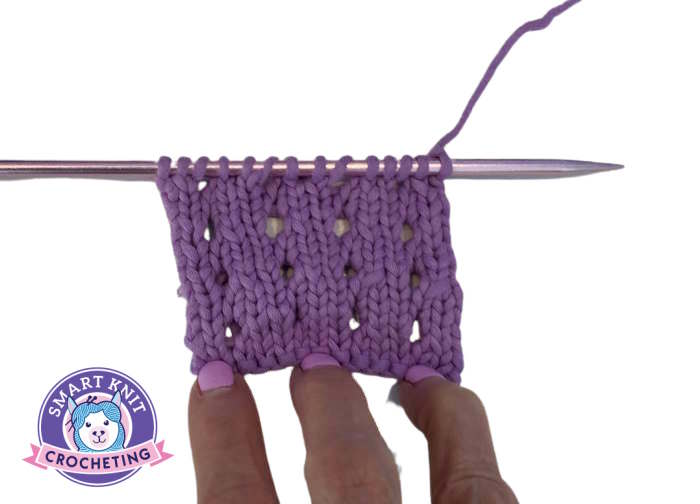
This is another easy lace pattern that creates eyelets every three rows. It is not reversible but can be used in several easy projects, including shawls, cowls, and scarves. It also works well if you are making fingerless gloves. It does require a cast on of multiples of 3 plus two. I cast on 12 plus 2 or 14 stitches for the swatch pictured.
Cast On: Multiples of 3 + 2
Row 1: (RS): Knit
Row 2: Purl
Row 3: K2, *yo, k2tog, k1; rep from * to end
Row 4: Purl
4. Knit Lace Granite Stitch
 Knit Lace Granite Stitch
Knit Lace Granite StitchThe Granite Lace Knitting Stitch is an intriguing and sophisticated knitting pattern, often admired for its distinctive combination of complexity and elegance. The fabric produced is lacy and that criss-cross design is reminisce of granite rock. It is created by working a row of knitting decreases and then a row of increases. This tutorial provides a step-by-step photo tutorial for making these knitting increases and decreases.
Learn how to make the Knit Lace Granite Stitch
5. Straight Lace Knitting Stitch
 Straight Lace Knitting Stitch
Straight Lace Knitting StitchThis is an easy beginner-friendly lace stitch that uses three stitches: The knit stitch, Yarn over, and the Knit 2 together. Since it is a one-row repeat, it hard to get lost or confused when making this stitch.
Learn how to make the Straight Lace Knitting Stitch.
6. Old Shale Lace Pattern
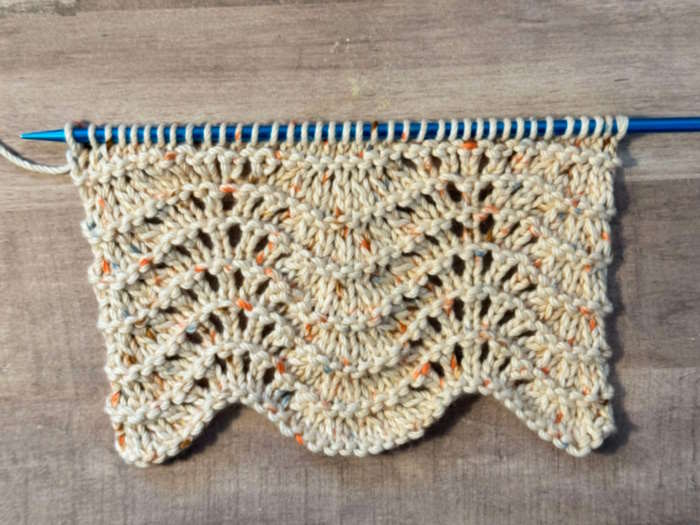
This simple yet effective pattern creates a wave-like design, making it perfect for various projects, including scarves, shawls, blankets, and even garments.
Learn How to Make the Old Shale Pattern
7. Open Honeycomb Stitch
The Open Honeycomb Stitch is a good option for the adventurous beginner as it uses only yarn overs and slip, slip knits to create eyelets perfect for a light, airy fabric.
Learn How to Make the Open Honeycomb Stitch
Lace Knitting Stitches: Pin for Future Reference
Eyelet Mock Cable Ribbing

This swatch pattern falls into several different catagories of knit stitches, but I've included it here because it is an eyelet stitch and an easy beginner friendly pattern that includes purls and knits with a couple additional techniques that are not difficult to learn.
Directions
The pattern is worked on multiples of 5 + 2
Row 1 (RS): P2, *sl 1 purlwise, k2, psso, p2; rep from * to end.
Row 2: K2, *p1, yrn, p1, k2; rep from * to end.
Row 3: P2, *k3, p2; rep from * to end.
Row 4: K2, *p3, k2; rep from * to end.
Work these four rows for the pattern until you reach your desired length. Bind off, and weave in ends.
Learn more about the Eyelet Mock Cable Ribbing Stitch
Tips for Making Lace Knitting Stitches
- Learn to read your stitches if you lose your place.
- Throw yourself a lifeline "just in case."
What can you make with this easy lace stitch pattern?
- Scarf
- Shawl
- Table Runner
- As the edge of a garment
Conclusion
Lace knitting skills can be a challenging but rewarding technique to master. By using the right tools, understanding lace knitting patterns, and practicing regularly, you can become a master of this intricate art form.
Whether you're a beginner or an experienced knitter, plenty of resources are available to help you improve your skills and create beautiful lace knitting projects. Before you know it, you'll be on your way to making your designs!
Happy Knitting

